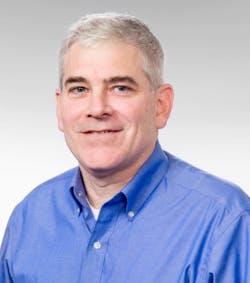Algorithms to Antennas: A Blog for 5G, Radar, and EW RF Engineers
Hello, fellow RF/microwave enthusiasts. My name is Rick Gentile. In my role at MathWorks, I focus on technology that helps system architects and RF/microwave engineers design and develop wireless systems. This includes emerging 5G, radar, and electronic-warfare (EW) systems. Prior to joining MathWorks, I worked on the development of many large radar systems in addition to communications projects. From this experience, I developed an understanding of the challenges microwave and RF engineers face.
I now work with 5G, radar, and EW RF engineers who face the similar, complex challenges of building wireless systems the most efficient way possible. This blog will focus on exploring those challenges and providing insights into solutions, including a collection of additional resources to help get you started.
Today’s RF systems rarely are designed to perform a single function. For example, new aerospace and defense systems have merged into integrated radar, EW, and communications systems. In 5G systems, the related challenges include characterizing the channel, connecting with multiple users, and maintaining channel capacity. Today’s systems also have to operate at higher frequencies with much wider bandwidths in more crowded RF spectrums.
All of these factors drive an increase in complexity for every aspect of the system. We see this both within individual systems and in the interactions between systems. The bottom line is that today’s RF designs are too complicated to not model every aspect of the design before anything is built.
At MathWorks, working with a large and diverse customer base provides insight into how much modeling improves the likelihood of success, especially as system complexity increases. Because wireless system design spans multiple signal domains, the technical disciplines required for success on projects can vary significantly. This can be a challenge when subsystems are built separately and integrated at the later stages of a project.
When you can gain insights into the full signal chain at the early phases of your development—from the antenna and array design, to the RF components, to algorithms you implement for signal processing—you have the greatest flexibility to make the most intelligent design choices. That is, each subsystem in a multi-domain subsystem contributes to the overall signal processing effort.
Many questions come to mind when the full system is considered early in a design cycle:
- Is it better to make a design change in the array?
- Could spatial signal processing algorithms eliminate interference from competing RF systems?
- Can a small change in the antenna element or antenna array spacing prevent more complicated design challenges downstream?
It can greatly improve the cost and schedule of a project when a small design change in one portion of a system eliminates the need for a more complex change somewhere else in the system.
Whether you are working on 5G wireless systems, radar, or EW, wireless systems are becoming more complex and integrated—which only increases the pressure to avoid costly mistakes. This monthly blog will explore the challenges and solutions 5G, radar, and EW engineers face while also providing models, examples, and techniques to help in overcoming those daily obstacles. I hope you’ll e-mail me with your feedback and thoughts along the way.
Learn more about topics covered in this blog post:
- Four Steps to Building Smarter RF Systems with MATLAB (white paper). Learn how to use system-level models to explore ideas and tradeoffs, optimize system performance, and better communicate with colleagues, customers, and suppliers.
- Transforming Wireless Design with MATLAB (e-book). Learn how to develop 5G technologies and model and simulate advanced, digitally controlled RF transceivers.
- Synthesizing an Array from a Specified Pattern: An Optimization Workflow (technical article). Learn two workflow examples using optimization techniques to quickly and efficiently converge a solution.
See additional 5G, radar, and EW resources, including those referenced in previous blog posts.
About the Author
Rick Gentile
Product Manager, Phased Array System Toolbox and Signal Processing Toolbox
Rick Gentile is the product manager for Phased Array System Toolbox and Signal Processing Toolbox at MathWorks. Prior to joining MathWorks, Rick was a radar systems engineer at MITRE and MIT Lincoln Laboratory, where he worked on the development of several large radar systems. Rick also was a DSP applications engineer at Analog Devices, where he led embedded processor and system level architecture definitions for high performance signal processing systems used in a wide range of applications.
He received a BS in electrical and computer engineering from the University of Massachusetts, Amherst, and an MS in electrical and computer engineering from Northeastern University, where his focus areas of study included microwave engineering, communications, and signal processing.


